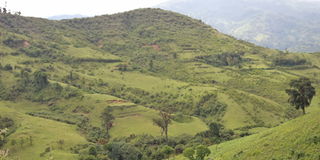Showdown over Sh600m Cherangany water tower conservation bid

A section of the Embobut forest which is part of the Cherangany water tower, that has been massively depleted over years. The Sengwer community has opposed a forest conservation project, fearing evictions.
A showdown is brewing between the Sengwer community in the Rift Valley and a community-based organisation over the proposed Sh600 million rehabilitation and conservation of the wantonly degraded Cherangany Hils water tower.
The Cherangany Hills water tower is one of the five major water
towers in Kenya, and an important watershed area for Lake Victoria and
Turkana. It hosts critical waters for Nzoia, Turkwel and Kerio Rivers.
Whereas a consortium of Marakwet Highlands groups has applied for the funding to conserve the water tower, the Sengwer community opposes the project, claiming that such projects were previously used to evict them from the forest.
They cite human rights violations committed against them during evictions as the main reason they don’t want the funding through the National Environmental Trust Fund (NETFUND) to be considered.
Not consulted
In a September 3 letter from their chairman Paul Kitum, the Sengwer said they were not consulted about the project and are not ready to be evicted from the forest, which they say is their ancestral land.
“Conservation agencies design their project in boardrooms, towns and cities without [involving] the Sengwer community at the inception of the project, despite the Sengwer people being the major stakeholders in conservation of [the] Cherangany hills ecosystem. That cannot be wished away,” they protested in the letter.
It was sent to the Italian government, who are the donors, the Ministry of Environment, Forestry and Natural Resources, NETFUND and other state agencies.
“The Sengwer community have been suffering immense forceful evictions, serious human rights violations that have led to loss of lives, torture, arrests and disruption of the community social as well as economic status as a result of conservations projects in Cherangany hills,” Mr Kitum wrote.
He lamented that the community is usually involved towards the tail end of implementation of projects, saying this negates free, prior and informed consent.
“In line with the national, regional and international laws and policies of risk assessment and safeguard policies in any given project design and implementation, [the host community should be involved], which is not the case here,” he said.
Demand recognition
Consequently, Mr Kitum demanded recognition of the land tenure rights of the Sengwer in the Cherangany hills to own, live, manage and use sustainably the three glades of Kapkok, Kaptirbai and Koropkwen in Embobut forest under conservation conditions.
“This is our key and priority and we can only engage with the government led conservation projects in Cherangany Hills Water Tower once it recognizes us as the rightful owners of the aforementioned territories,” he said.
“Any conservation donor agency should take this seriously before funding conservation in these areas.”

A chief points at the depleted part of Embombut forest. The Sengwer community is opposed to a forest conservation project, fearing evictions.
The community said any conservation projects targeting the Cherangany hills water tower should take a human rights-based approach to avoid rights violations as witnessed in past conservation projects.
“No project should … be used to divide, intimidate and harass the Sengwer indigenous community leadership in Cherangany hills,” they argued.
Marginalised
Projects “should not be used to further marginalize the Sengwer community, instead they should offer support [to] community members in applying their indigenous conservation knowledge”.
Gilbert Chesewew, the chairman of the consortium of community-based organisations (CBOs), faulted the Sengwer community ‘on their penchant’ for blocking any funding meant to rehabilitate the dwindling forest.
“This is purely activism for economic gain. Blocking all donor funding, including those targeting Community Forest Associations (CFAs) and CBOs, can wage war among the communities in the Cherangany ecosystem,” he told Nation.
Donor funding blocked
He accused the community of blocking Sh3.7 billion the European Union had released for conservation of the water tower and another Sh300 million from other donors.
“The government should unlock their conflict with the Sengwer community to avoid further blocking of conservation funds and livelihood schemes for other indigenous in Cherangany hills communities,” he said.
“Alternatively, subdivide the ecosystem conservation areas like Kerer forest blocks, Koisungur forest blocks, and Kipkunur forest blocks for easy administration and management.”
Alternative income sources
Communities in the crucial ecosystem should be supported to get alternative sources of income, hence their decision to reach out to donors for assistance, he said.
“For a long time, these people have valued and coexisted with the natural forest in their own farms as well as the adjacent State forest,” he said.
“The recent development of cutting trees in their own farms to cater for domestic needs will contribute to mass destruction of the forest that will eventually cause a rise in temperatures and other climatic changes.”
According to a Kenya Water Towers Agency (KWTA) policy brief, between 1990 and 2016, there was an overall loss of 13,003ha of forest cover in the Cherangany hills water tower, equivalent to an annual loss of 500ha.
KWTA says the water tower is facing serious threats ranging from
encroachment, over-exploitation of its resources, illegal logging of indigenous tree species, rampant charcoal production and unsustainable land management practices.





